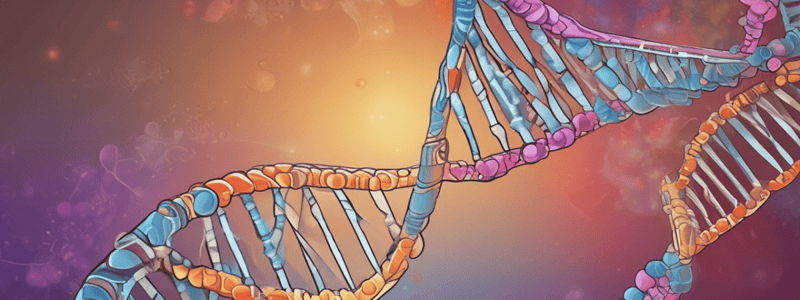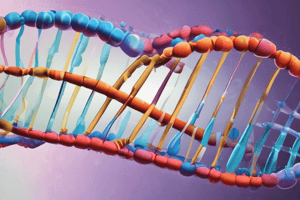Podcast
Questions and Answers
What is the function of DNA polymerases?
What is the function of DNA polymerases?
- To unwind the double helix
- To transcribe genes into proteins
- To synthesize RNA molecules
- To proofread and repair newly made DNA (correct)
What is the purpose of mismatch repair?
What is the purpose of mismatch repair?
- To replicate DNA
- To correct errors in base pairing (correct)
- To transcribe genes into proteins
- To unwind the double helix
What can cause DNA damage?
What can cause DNA damage?
- Exposure to harmful chemical or physical agents (correct)
- Normal cellular processes
- The absence of oxygen
- The presence of antioxidants
What is the result of spontaneous changes in DNA?
What is the result of spontaneous changes in DNA?
What is the function of nucleotide excision repair?
What is the function of nucleotide excision repair?
Which enzyme is involved in leading strand synthesis?
Which enzyme is involved in leading strand synthesis?
What is the role of the connecting protein?
What is the role of the connecting protein?
What is the direction of the lagging strand?
What is the direction of the lagging strand?
What is the distance between the two sugar molecules in a DNA double helix?
What is the distance between the two sugar molecules in a DNA double helix?
What is the term for the process where a double helix replicates, resulting in each daughter molecule having one old strand and one newly made strand?
What is the term for the process where a double helix replicates, resulting in each daughter molecule having one old strand and one newly made strand?
Which of the following is a correct feature of the partial chemical structure of DNA?
Which of the following is a correct feature of the partial chemical structure of DNA?
What is the term for the model where the two parent strands rejoin after replication?
What is the term for the model where the two parent strands rejoin after replication?
What is the distance between the two phosphate groups in a DNA double helix?
What is the distance between the two phosphate groups in a DNA double helix?
Which of the following nucleotides pairs with Adenine?
Which of the following nucleotides pairs with Adenine?
What is the term for the model where each strand is a mix of old and new nucleotides after replication?
What is the term for the model where each strand is a mix of old and new nucleotides after replication?
Which of the following is NOT a correct feature of the space-filling model of DNA?
Which of the following is NOT a correct feature of the space-filling model of DNA?
What is the consequence if chromosomes of germ cells become shorter in every cell cycle?
What is the consequence if chromosomes of germ cells become shorter in every cell cycle?
What is the function of telomerase in germ cells?
What is the function of telomerase in germ cells?
What is the shape of the DNA molecule in a bacterial chromosome?
What is the shape of the DNA molecule in a bacterial chromosome?
What is the term for the complex of DNA and protein found in the nucleus of eukaryotic cells?
What is the term for the complex of DNA and protein found in the nucleus of eukaryotic cells?
What is the purpose of telomerase activity in cancer cells?
What is the purpose of telomerase activity in cancer cells?
What is the region of the cell where the DNA is found in a bacterium?
What is the region of the cell where the DNA is found in a bacterium?
Why might the shortening of telomeres protect cells from cancerous growth?
Why might the shortening of telomeres protect cells from cancerous growth?
How do chromosomes fit into the nucleus of eukaryotic cells?
How do chromosomes fit into the nucleus of eukaryotic cells?
What is a germ-line mutation?
What is a germ-line mutation?
What is the mutation rate?
What is the mutation rate?
What is a transition mutation?
What is a transition mutation?
What is the result of a base-pair substitution?
What is the result of a base-pair substitution?
What is mutagenesis?
What is mutagenesis?
What are spontaneous mutations?
What are spontaneous mutations?
What is the mutation frequency?
What is the mutation frequency?
What is a transversion mutation?
What is a transversion mutation?
What is the direction of DNA pol III synthesis on the leading strand?
What is the direction of DNA pol III synthesis on the leading strand?
Where does DNA pol III start synthesizing the new strand?
Where does DNA pol III start synthesizing the new strand?
What is synthesized in short fragments on the lagging strand?
What is synthesized in short fragments on the lagging strand?
What type of mutation involves a change of one or a few base pairs?
What type of mutation involves a change of one or a few base pairs?
What is the result of a mutation occurring in a somatic cell?
What is the result of a mutation occurring in a somatic cell?
What is the process by which the sequence of base pairs in a DNA molecule is altered?
What is the process by which the sequence of base pairs in a DNA molecule is altered?
What is the role of primase in DNA replication?
What is the role of primase in DNA replication?
What replaces the RNA primer with DNA nucleotides?
What replaces the RNA primer with DNA nucleotides?
Flashcards are hidden until you start studying
Study Notes
DNA Structure
- The DNA molecule has a double helix structure with a sugar-phosphate backbone and nitrogenous bases (adenine, guanine, cytosine, and thymine) that pair with each other (A-T and G-C) through hydrogen bonds.
- The distance between each pair of nucleotides is 0.34 nm, and the distance between each turn of the helix is 3.4 nm.
DNA Replication
- Watson and Crick's semiconservative model of replication predicts that each daughter molecule will have one old strand (derived from the parent molecule) and one newly made strand.
- The leading strand is synthesized continuously in the 5' to 3' direction, while the lagging strand is synthesized in short Okazaki fragments that are later joined by DNA ligase.
- DNA polymerase III synthesizes the leading strand, and DNA polymerase I replaces the RNA primer with DNA nucleotides.
Proofreading and Repairing DNA
- DNA polymerases proofread newly made DNA and replace any incorrect nucleotides.
- Mismatch repair corrects errors in base pairing.
- Nucleotide excision repair cuts out and replaces damaged stretches of DNA.
- DNA can be damaged by exposure to harmful chemicals or physical agents, such as cigarette smoke and X-rays.
Telomeres
- Telomeres are the ends of chromosomes that shorten with each cell cycle.
- Telomerase catalyzes the lengthening of telomeres in germ cells.
- The shortening of telomeres might protect cells from cancerous growth by limiting the number of cell divisions.
Chromosomes
- A chromosome consists of a DNA molecule packed together with proteins.
- Bacterial chromosomes are double-stranded, circular DNA molecules associated with a small amount of protein.
- Eukaryotic chromosomes have linear DNA molecules associated with a large amount of protein.
- Chromatin is a complex of DNA and protein found in the nucleus of eukaryotic cells.
Mutations
- Mutations are changes in the sequence of base pairs in a DNA molecule.
- Point mutations are changes of one or a few base pairs.
- Mutations can occur through spontaneous changes, errors in the replication process, or the action of radiation or particular chemicals.
- A mutation may result in a change to either a DNA base pair or a chromosome.
- A cell with a mutation is a mutant cell.
Types of Mutations
- Somatic mutations occur in somatic cells and affect only the individual in which the mutation occurs.
- Germ-line mutations occur in the germ line of sexually reproducing organisms and can be transmitted to the next generation.
- Base-pair substitutions can be either transition mutations (from one purine-pyrimidine base pair to the other) or transversion mutations (from a purine-pyrimidine base pair to a pyrimidine-purine base pair).
Mutation Rates and Frequencies
- The mutation rate is the probability of a particular kind of mutation as a function of time.
- The mutation frequency is the number of occurrences of a particular kind of mutation, expressed as a proportion of cells or individuals in a population.
Studying That Suits You
Use AI to generate personalized quizzes and flashcards to suit your learning preferences.



